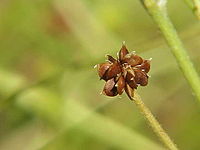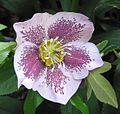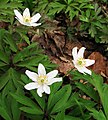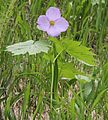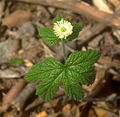|
Ranunculaceae
Ranunculaceae (/rənʌŋkjuːˈleɪsiˌaɪ, -siːˌiː/, buttercup or crowfoot family; Latin rānunculus "little frog", from rāna "frog") is a family of over 2,000 known species of flowering plants in 43 genera,[2] distributed worldwide. The largest genera are Ranunculus (600 species), Delphinium (365), Thalictrum (330), Clematis (380), and Aconitum (300). Description Ranunculaceae are mostly herbaceous annuals or perennials, but some are woody climbers (such as Clematis)[3] or shrubs (e.g. Xanthorhiza). Most members of the family have bisexual flowers which can be showy or inconspicuous. Flowers are solitary, but are also found aggregated in cymes, panicles, or spikes. The flowers are usually radially symmetrical but are also found to be bilaterally symmetrical in the genera Aconitum and Delphinium.[4][5] The sepals, petals, stamens and carpels are all generally free (not fused), the outer flower segments typically number four or five. The outer stamens[a] may be modified to produce only nectar, as in Aquilegia, Helleborus and Delphinium.[5] In some genera, such as Thalictrum, the sepals are colorful and appear petal-like (petaloid) and the petals can be inconspicuous or absent.[3] The stems are unarmed. The leaves are variable. Most species have both basal and cauline (stem) leaves, which are usually compound or lobed but can be simple. They are typically alternate, or occasionally opposite or even whorled. Many species, especially the perennials, form rhizomes that develop new roots each year.[6] Ficaria verna can reproduce vegetatively by means of root tubers produced in the leaf axils.[3][4] Some members of the genus Thalictrum utilize anemophily while others utilize entomophily.[8] Flowers of the entomophilous genus Papaver, also of the Ranunculales order, produce only pollen.[9] Until recently, it was believed that the species of the genus Anemone also lack nectar.[10] The fruits are most commonly free, unfused achenes (e.g. Ranunculus, Clematis) or follicles (e.g. Helleborus, Eranthis, Nigella), but a berry in Actaea.[3][4] PhytochemistryRanunculaceae contain protoanemonin, which is toxic to humans and animals. Contact with plant sap may cause inflammation and blistering of the skin, while ingestion can cause irritation of the mouth, vomiting, and diarrhea.[11] Other poisonous or toxic compounds, alkaloids and glycosides, are also common.[citation needed] TaxonomyTakhtajan (1997) included the Ranunculaceae as the only family in the Ranunculales which he placed in a subclass, the Ranunculidae, instead of a superorder. Previously, Thorn (1992) placed the Ranunculaceae in the Berberidales, an order within the Superorder Magnolianae. Earlier Cronquist in 1981 included the Ranunculaceae along with seven other families in the Rancunculales which was included in the Magnoliidae, which he regarded as a subclass.[12] David, (2010)[13] placed the Ranuculaceae, together with the Eupteleaceae, Lardizabalaceae, Menispermaceae, Berberidaceae, and Papaveraceae in the Ranunculales, the only order in the superorder Ranunculanae. This follows the work of the Angiosperm Phylogeny Group. The family Ranunculaceae sensu stricto is one of seven families included in the order Ranunculales within the eudicots according to the Angiosperm Phylogeny Group (APG) classification.[14] The family is monophyletic with Glaucidium as sister to the remaining genera.[15] This phylogeny is illustrated in the APG Poster.[16] SubdivisionEarly subdivisions of the family, such as Michel Adanson (1763), simply divided it based on one-seeded or many-seeded fruit. Prantl (1887) envisaged three tribes, Paeonieae, Helleboreae and Anemoneae with Paeonia, Glaucidium and Hydrastis forming Paeonieae. By the twentieth century Langlet (1932) used chromosome types to create two subfamilies, Ranunculoideae and Thalictroideae. In 1966, Tamura further developed Langlet's system by adding floral characteristics with six subfamilies; but by 1988 he had reduced Coptidoideae to a tribe within Isopyroideae, leaving five subfamilies, an arrangement he continued in his 1993 monograph, dividing the larger subfamilies into tribes, though by then Paeonia and Glaucidium were no longer considered to belong to Ranunculaceae.[17] Paeonia was separated from Ranuculaceae and placed in its own family of Paeoniaceae (order Saxifragales). Other genera originally included in Ranunculaceae include Circaeaster, which was placed in its own family Circaeasteraceae. Tamura's complete system was structured as follows;
The genus Glaucidium, having been moved to its own family (Glaucidiaceae), has since been restored to Ranuculaceae. Molecular phylogeneticsWhen subjected to molecular phylogenetic analysis, only Thalictroideae is monophyletic. The position of Glaucidium and some of its unique morphological characteristics prompted Stevens to suggest that it be given subfamilial rank as the monotypic Glaucidioideae. Similarly, Hydrastis has been assigned to subfamily Hydrastidoideae.[18][15] Both genera are represented by a single species, Glaucidium palmatum and Hydrastis canadense respectively. The relationships between the genera suggest the existence of three major clades corresponding to Coptidoideae, Thalictroideae (clade A) and Ranunculoideae (clade F). The latter is the largest with four subclades (B–E). Of these, C corresponds to Delphineae, D to Cimicifugae and E to Ranunculoideae.[15] Consequently, Wang and colleagues (2009) proposed a new classification with five subfamilies, and further subdividing Ranunculoideae into ten tribes. The relationship between the subfamilies is shown in the cladogram (see below). In addition to the two monotypic subgenera, Coptoideae has 17 species and Thalictroideae has 450, including Thalictrum and Aquilegia. The other genera (2025 species, 81% of the family) belong to Ranunculoideae. Kingdonia had been included by Tamura in Anemoneae, but is now added to Circaeasteraceae. In recent years, researchers have used nuclear genes (obtained through transcriptome sequencing technology) to further investigate the phylogenetic relationships of the Ranunculaceae family, and their findings are consistent with those of Wang and colleagues (2009). However, this study indicates that the ancestors of the Ranunculaceae family experienced multiple whole-genome duplication (WGD) events, which may be related to the longstanding prosperity of this ancient group.[19]
GeneraRanunculaceae contains approximately 43 genera.[2][20]
Previous genera
Fossil recordContrary to earlier data, there are no confirmed pre-Tertiary ranunculacean fossils.[21] The Early Cretaceous Leefructus mirus from the Yixian Formation in China was described as belonging to the "compare Family stem lineage to the Ranunculaceae".[22] The oldest confirmed representative of the family is Paleoactaea nagelii Pigg & DeVore described on the basis of fruits coming from the Upper Paleocene of North Dakota.[1] UsesSome Ranunculaceae are used as herbal medicines because of their alkaloids and glycosides, such as Hydrastis canadensis (goldenseal), whose root is used as a tonic. More than 30 species are used in homeopathy, including Aconitum napellus, Actaea racemosa, Clematis recta, Clematis virginiana, Hydrastis canadensis, Ranunculus bulbosus, Helleborus niger, Delphinium staphisagria, Pulsatilla nigricans. Many genera are well known as cultivated flowers, such as Aconitum (monkshood), Clematis, Consolida (larkspur), Delphinium, Helleborus (Christmas rose), Trollius (globeflower). The seeds of Nigella sativa are used as a spice in Indian and Middle Eastern cuisine.[23] GalleryTribes of subfamily Ranunculoideae
Other subfamilies
NotesReferences
Bibliography
External linksWikimedia Commons has media related to Ranunculaceae. Wikispecies has information related to Ranunculaceae.
|
||||||||||||||||||||||||||||||


